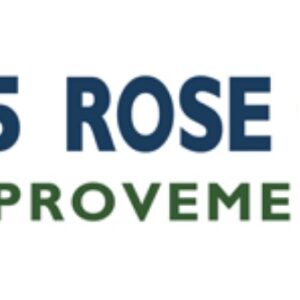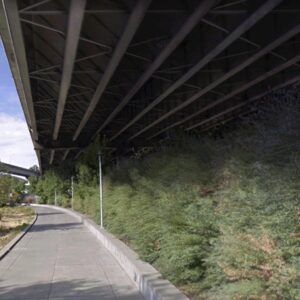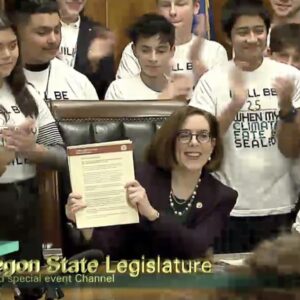
(Photo © J. Maus/BikePortland)
Tonight was supposed to be the first meeting of the I-5 Rose Quarter Project Community Advisory Committee. Due to public health concerns, it has been postponed and will be rescheduled in an online-only format (public will be invited, see updated details below). This is the committee foisted upon the Oregon Department of Transportation by their bosses on the Oregon Transportation Commission to try and get a handle on the thorny public debates surrounding the controversial project.
Back in January we encouraged readers to apply and it appears that a least a few of you did. I noticed lots of familiar names among the 147 applicants. In the end, ODOT selected 24 people. Here are their names, with a selected blurb from their application (followed by several other important project updates):
David Anchel
“I own Elmer’s Flag and Banner. I spend the majority of my waking hours managing my business in the Irvington/Lloyd area of Broadway. What happens next on this project directly affects me and my 15 or so employees. I also commute by bicycle and would appreciate the opportunity to do that (more) safely.”
Brad Baker, Eliot Neighborhood Association
“I am the chair of the Eliot Neighborhood Association’s Land Use and Transportation Committee… Right now, there are little to no local benefits, and lots of local downsides. I’d be interested in pushing it so that the opposite is true.”
Pastor Craig Brown, St. Paul Missionary Baptist Church
“As a Pastor, Government employee and retired military, I deal with challenges all the time… In this case how can the challenging issues be solved, what matrix will we use, What will be the group/team concept as we approach the issue. What’s our end-state?”
Advertisement
Steve Cackley
“I have been rooted in albina for almost 50 years… I live in the Humboldt neighborhood in a house I bought in 1976. The freeway is a piece of getting around and i am interested in helping to make this project the least painful process it can be.”
Andrew J. Campbell, Multnomah County Racial and Ethnic Approaches to Community Health (REACH)
“To minimize harm to our most vulnerable communities, and demonstrate inclusion is tantamount to what I bring to the committee process.”
Robert S. Carroll, Columbia Pacific Building and Construction Trades Council (Union)
“In my opinion the Rose Quarter Improvement Project is needed to alleviate a number of issues that negatively impact the Rose Quarter.”
Natasha Coleman
“I have grown up in this community and have watched it change drastically. Unfortunately the members it directly affects as not the ones who are making the decisions…”
Clint Culpepper, Portland State University
“This project has the potential to repair a neighborhood that has historically been negatively impacted by large projects. I see the opportunity for improvements in freeway traffic, neighborhood livability, and public transportation to be fantastic opportunities for the city of Portland.”
Cleo Davis
“[I want to join this committee] To contribute to the future of African American prosperity and overall future growth of the city of Portland.”
Liz Fouther-Branch
“I was born and raised in the very area under consideration and have had family members displaced due to I5 Corridor, Memorial Coliseum and Emmanuel Hospital.”
Advertisement
Jasmine Gadie
“I am an African-American resident of North Portland who has been directly impacted by the urban renewal of the area.”
Tristan Isaac, Bus Riders Unite
“My interest in participating in this community advisory committee is to bring a radical political lens to the planning process…”
Jon Isaacs, Portland Business Alliance
“The successful completion of this project has been identified as one of the top policy priorities by the members of the Portland Business Alliance for 2020… I am the former Chief of Communications of Public Affairs for Portland Public schools, and Executive Director of the Oregon League of Conservation Voters… I have a detailed understanding of the importance of this project to the overall economic health of the region.”
Saumya Kini
“I am interested in advocating for greater investment in and focus on public transit and bicycle infrastructure…”
Olivia Lufkin, Portland Public School Student
(Application not available)
Bianca Montás (Youth)
“I would like to be more included within my community, especially in regards to big projects that will impact many people and communities- specifically people of color and low-income families.”
Brett Morgan, 1000 Friends of Oregon
“1000 Friends seeks to bring expertise in land use policy, particularly around Oregon’s Planning Goal 12 (transportation planning), and Goals 1 (citizen involvement in planning). (He’s also a Kenton resident.)
Christopher John O’Connor
“I work as a public defender and have thousands of past clients impacted by the history, traffic and public transportation of the impacted area.”
Shannon Olive, WomenFirst Transition and Referral Center
“Our black communities used to live in the project area, I truly believe that those jobs should be prioritized to our black communities.”
Shawn Penney
“I’m an active community activist in North and Northeast Portland, I care about the community that I live and work in.”
Carolyn Stoudamire
“I have lived in this neighborhood since 1956 and I have seen many changes and displacement.”
Jenny Taylor, Go Lloyd
“[At Go Lloyd] we have a vested interest in the project. Our board of directors includes representatives of large and small employers, residents of Lloyd and adjacent communities, property owners and managers, and public agencies. As a member of the CAC, I will represent their consensus viewpoint…”
Advertisement
Claire Vlach, Oregon Walks
“I’d like to help ensure that any redesign includes an attractive, safe, and convenient environment for pedestrians through the use of elements like continuous sidewalks, safe crosswalks, street trees, and pedestrian-oriented street lights. “
Diane E. Williams
“My hope is that as this project moves forward, it will make the surrounding area a priority in itself, and seriously pursue the potential for reconnecting some of those divides and healing those scars.”
ODOT says this committee will meet up to nine times per year. If you’re how much power the CAC will have, the answer isn’t clear. While ODOT has promised to, “work directly with the CAC to understand community concerns, values and perspectives,” it’s worth noting that every person on the roster agreed to a statement that said (in part, via a survey taken by all applicants): “I understand that… the purpose is to share information and provide advice, not make decisions.” Learn more on the official CAC website.
In related project news…
– Volunteers with No More Freeways are once again hustling to encourage everyone to submit comments to the OTC. As we reported last week, in addition to postponing a vote on the environmental analysis question until April 2nd, the OTC has opened a two week comment period. They want to know specifically, whether the OTC should recommend that ODOT do a full Environmental Impact Statement or stand pat with the existing (and less robust) Environmental Assessment. Yes, it seems odd to ask for more public comment on this as it should be crystal clear that most people who are paying attention — including most every major elected leader in Portland — feels the EIS is imperative. You can comment on the OTC website.
– Some activists think Oregon Governor Kate Brown’s executive order on climate change might provide legally-binding leverage to halt and/or delay the project.
– The City of Portland Bureau of Transportation is ostensibly a 50/50 partner parter with ODOT on this project. But the bureau’s own Budget Advisory Committee has grave concerns about it. On March 6th, the committee signed off on a letter to PBOT Director Chris Warner (with cc’s to all five OTC members) calling for the full EIS, saying it’s, “Essential to ensure that the project aligns with Portland’s goals for climate change and equity.” The Bureau Budget Advisory Committee also said they support a project Executive Advisory Committee with, “… Oversight authority throughout the duration of the project.”
– Members of Metro’s Joint Policy Advisory Committee on Transportation are scheduled to take up the Rose Quarter project at their virtual meeting tomorrow (3/19). As detailed in this memo provided by Metro in the meeting package, they will discuss adding $106 million worth of project costs for the preliminary engineering and right-of-way phases into their Metropolitan Transportation Improvement Plan (MTIP) project list.
Congratulations! You’re all caught up!
UPDATE: ODOT just announced that the first project CAC meeting, an online meet-and-greet will be held March 25th from 4:00 to 6:00 pm. They’ll use the Zoom meeting platform. More details on ODOT website.
— Jonathan Maus: (503) 706-8804, @jonathan_maus on Twitter and jonathan@bikeportland.org
— Get our headlines delivered to your inbox.
— Support this independent community media outlet with a one-time contribution or monthly subscription.





Thanks for the update, Jonathan!
For folks who missed that link to comment for the EIS, it’s here on the NMF website:
http://www.nomorefreewayspdx.com/YESEIS
the public comment period closes Friday March 27th at 5pm so please please please get that email in!
Technical detail: JPACT isn’t part of Metro, rather Metro is part of JPACT, since JPACT also includes Clark County, WashingtonDOT, & Vancouver, none of whom are represented on Metro. JPACT does in fact advise Metro, but it also advises a lot of other bodies too.
JPACT is the metropolitan planning organization (MPO) for the Portland-Vancouver metro area; Metro is the state-mandated regional government for the Oregon side of the metro area; the Washington side doesn’t have the same kind of regional government. JPACT’s legal basis is mandated by USDOT/FHWA/FTA rather than by the Oregon or Washington state governments. The Feds also regularly send non-voting representatives to every meeting. Like most MPOs, JPACT rarely (i.e. never) blocks a project that is already funded by either state DOT or by member cities, but they do play a useful role in lobbying Congress for more funding.
Since Metro has most of the population and resources in the metropolitan area, most (but not all) JPACT meetings take place at the Metro office. Most of JPACT’s staffing is also from Metro. In general, JPACT divides the regional funding for the Oregon & Washington sides of the metropolitan area. The Oregon representatives don’t interfere with SW Washington projects and vice versa. The only area of potential conflict are bridge projects over the Columbia River, so while the SW Washington group only has 3 votes (a small minority), they have effective veto power over joint bridge projects by refusing to pay their share.
https://www.oregonmetro.gov/regional-leadership/metro-advisory-committees/joint-policy-advisory-committee-transportation
Roster (pdf): https://www.oregonmetro.gov/sites/default/files/2019/08/09/2019-Joint-Policy-Advisory-Committee-on-Transportation-member-Roster.pdf
Thanks, Jonathan, for all of your good reporting on this issue.
I found a typo – actually a word is missing:
ODOT says this committee will meet up to nine times per year. If you’re [wondering?] how much power the CAC will have, the answer isn’t clear.
Please forgive my skepticism, but I would bet you 20 lira that the CAC is a paper tiger. It’s OTC’s way of telling everyone, “You had your say. Now bring on the bulldozers!”
They seem to have weighted the committee with mostly NoPo residents who will talk about how the area was before I-5 was put through. But they’re not gonna remove I-5, so what good will those discussions do?
Nope – I’m afraid the CAC is an attempt to paper over the cracks in a flawed process and justify a decision that was made long ago.
You are correct, the CAC isn’t there to stop the project, but to advise on design:
The CAC’s purpose is to bring community interests and values into the project’s decision-making process regarding design aspects of the project that most directly affect the local community. Operationally, CAC members will review project information and provide interest and value-based advice and feedback to the project team, who will utilize these CAC outcomes to substantively inform their recommendations to the Oregon Transportation Commission (OTC) and ODOT.
The CAC advises the project team on topics including but not limited to:
– Highway cover design(s) that are responsive to community needs, and aesthetic desires.
– Design of pedestrian and bicycle connections to improve movements for people within and through the project area.
– Construction considerations, including construction phasing options.
– Objectives, implementation, and monitoring of the Public Involvement Plan (PIP), equity in project decisions, and design criteria for discussions to ensure meaningful and equitable community engagement during the project’s pre-construction process.
Sorry, but I don’t believe the CAC will make one iota of difference. I’ve been involved in way too many Portland projects in which the public involvement was outsourced to some company that provided The Illusion of Inclusion™℠®©. There’s a whole public-involvement industry here, funded by taxpayers.
If anyone can show me ONE thing the CAC did to make a meaningful difference in this project, I will ride a unicycle around City Hall wearing nothing but my skivvies.
“There’s a whole public-involvement industry here, funded by taxpayers.”
I completely agree with you. It’s all part of the “Nonprofit Industrial Complex” that also involves consultants, government planning agencies, neighborhood associations, appointed public commissions, freelance investigative journalists, and the like. As a community advocate, I’m certainly part of it, as is Jonathan, and to a certain extent anyone who responds to this blog.
I have participated in CAC-like bodies for at least 17 years now. Most of the people participating are passive sheep who rubber-stamp every decision by staff and are attending because they want to do public service and/or get a free education, but some do great things working in the background, and many others are in-your-face advocates. Success is usually measured in very small increments, if at all. It’s a slow painful but necessary part of democratic government, available for those paid to be there, those rich enough to attend middle-of-the-workday meetings, and those who are rabid fervent fanatics like myself – the 0.1% who care enough to try to do something, even if it’s ultimately ineffective.
I think Troutdale and Fairview should have halted the I-84/Graham Road and Jordan Road improvement then. And Tualatin and Metzger should have halted the recent I-5 safety improvements.
Due process, dammit! Arlington, North Powder, Cottage Grove, Pendleton, Boardman, Meacham, Coburg, Creswell, Myrtle Creek….Just say NO to any Interstate System improvements through your burg.
I love that the first name that appears in the applications PDF is Aaron Brown because they are listed alphabetically 🙂
I had a thought– during the COVID-19 emergency, we’re really seeing that we don’t need to expand our freeways or highways as more and more people work remotely. We can probably accomplish the goal in reduction of congestion if businesses continue having employees work remotely after this. Just a thought that doesn’t really have to do anything with the article.